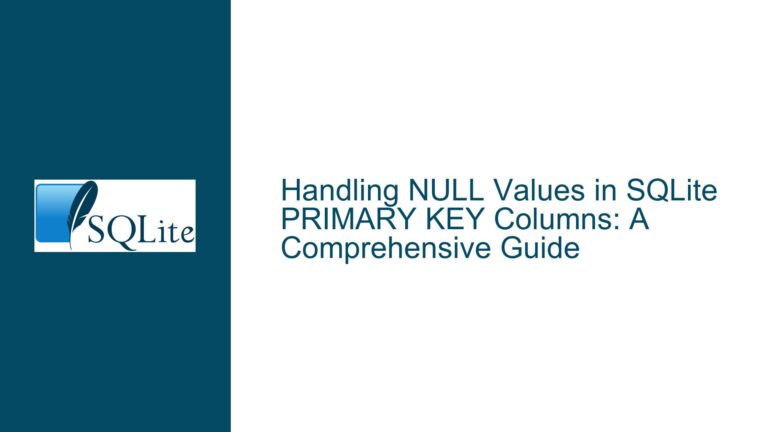Optimizing Geopoly Virtual Tables with Primary Keys in SQLite
Geopoly Virtual Table Lacks Explicit Primary Key Definition
When working with SQLite’s Geopoly extension, one of the most common issues developers encounter is the inability to explicitly define a primary key in the Geopoly virtual table. Unlike traditional tables or even the R*Tree virtual tables, Geopoly tables come with predefined columns that cannot be altered or extended in the same way. The Geopoly virtual table automatically includes two columns: rowid and _shape. The rowid column serves as the integer primary key, while the _shape column contains the geometric description of the polygon.
This design can be confusing for developers who are accustomed to defining their own primary keys, especially when they need to optimize queries or establish relationships with other tables. For instance, in the provided scenario, the developer attempted to create a Geopoly table (path_index) with columns vehicle_id and begin_time, expecting to use these as part of a primary key. However, this approach does not align with how Geopoly tables are structured. The rowid column is inherently the primary key, and any additional columns specified during table creation are treated as supplementary data columns.
The confusion is further compounded when trying to integrate the Geopoly table with a related data table (pathway). The pathway table includes a BIGINT PRIMARY KEY column (id), which is not directly compatible with the rowid column of the Geopoly table. This mismatch can lead to inefficiencies in querying and data retrieval, particularly when attempting to join the two tables or perform spatial queries.
Misalignment Between Geopoly Table and Data Table Structures
The core issue stems from a misalignment between the structure of the Geopoly virtual table and the associated data table. In the example provided, the pathway table is designed with a BIGINT PRIMARY KEY column (id), which is intended to uniquely identify each record. However, the Geopoly table (path_index) uses the rowid column as its primary key, which is inherently an INTEGER type. This discrepancy in data types can cause issues when attempting to establish relationships between the two tables.
Additionally, the pathway table includes columns such as vehicle_id, begin_time, and rect, where rect is expected to contain a GeoJSON description of the polygon. The developer’s initial approach was to create a Geopoly table with vehicle_id and begin_time as additional columns, hoping to use these for quick querying. However, this approach overlooks the fact that the Geopoly table’s primary functionality is to store and query geometric data, with the _shape column being the primary focus.
The misalignment is further exacerbated by the fact that the pathway table uses a BIGINT type for its primary key, while the Geopoly table’s rowid is an INTEGER. Although SQLite does allow for some flexibility in data types, this inconsistency can lead to performance issues, especially when dealing with large datasets or complex queries. The rowid column in SQLite is optimized for fast lookups, and any deviation from its expected usage can result in suboptimal performance.
Correcting Table Definitions and Leveraging Geopoly’s Built-in Features
To address these issues, it is essential to correct the table definitions and leverage the built-in features of the Geopoly extension. The first step is to ensure that the primary key in the pathway table is defined as an INTEGER PRIMARY KEY instead of a BIGINT. This change aligns the pathway table’s primary key with the rowid column of the Geopoly table, ensuring compatibility and optimizing query performance.
The next step is to properly define the Geopoly table (path_index) without attempting to add additional primary key columns. Instead, the Geopoly table should be created with the necessary geometric data, and the rowid column should be used to establish a relationship with the pathway table. The following SQL statements demonstrate how to correctly define and populate the Geopoly table:
-- Corrected pathway table definition
CREATE TABLE IF NOT EXISTS pathway (
id INTEGER PRIMARY KEY, -- Changed to INTEGER
path BLOB,
vehicle_id TEXT,
begin_time BIGINT,
end_time BIGINT,
area DOUBLE,
rect TEXT, -- GeoJSON description of the polygon
block_id BIGINT,
layer_index TINYINT,
UNIQUE(vehicle_id, begin_time)
);
-- Corrected path_index table definition
CREATE VIRTUAL TABLE path_index USING geopoly();
-- Populating the Geopoly table with data from the pathway table
INSERT INTO path_index(rowid, _shape)
SELECT id, rect FROM pathway;
In this corrected setup, the pathway table’s id column is now an INTEGER PRIMARY KEY, which aligns with the rowid column in the path_index table. The path_index table is created without additional columns, and the INSERT statement populates it with the id and rect values from the pathway table. This approach ensures that the rowid column in the Geopoly table correctly references the primary key in the pathway table, enabling efficient querying and data retrieval.
Optimizing Queries with Geopoly’s Spatial Index
Once the table definitions are corrected, the next step is to optimize queries that involve spatial data. The Geopoly extension provides powerful spatial indexing capabilities that can be leveraged to improve query performance. For example, if you need to find all polygons that intersect with a specific area, you can use the geopoly_overlap function, which is optimized for spatial queries.
-- Example query to find intersecting polygons
SELECT pathway.*
FROM pathway
JOIN path_index ON pathway.id = path_index.rowid
WHERE geopoly_overlap(path_index._shape, geopoly_json('{"type":"Polygon","coordinates":[[...]]}'));
In this query, the geopoly_overlap function is used to find all polygons in the path_index table that overlap with a specified GeoJSON polygon. The JOIN clause ensures that the results include the corresponding data from the pathway table, allowing for a comprehensive query that combines spatial and non-spatial data.
Ensuring Data Integrity and Consistency
Another critical aspect of working with Geopoly tables is ensuring data integrity and consistency. Since the Geopoly table relies on the rowid column to reference records in the pathway table, it is essential to maintain the integrity of these references. This can be achieved by enforcing foreign key constraints and ensuring that any changes to the pathway table’s primary key are reflected in the Geopoly table.
-- Enabling foreign key constraints in SQLite
PRAGMA foreign_keys = ON;
-- Example foreign key constraint (if needed)
CREATE TABLE pathway (
id INTEGER PRIMARY KEY,
-- other columns...
FOREIGN KEY (id) REFERENCES path_index(rowid)
);
By enabling foreign key constraints, you can ensure that any changes to the pathway table’s primary key are automatically propagated to the Geopoly table, preventing orphaned records and maintaining data consistency.
Conclusion
In summary, the key to optimizing Geopoly virtual tables in SQLite lies in understanding the inherent structure of these tables and aligning them with related data tables. By ensuring that the primary key in the data table is an INTEGER type and leveraging the rowid column in the Geopoly table, you can achieve efficient and consistent data management. Additionally, taking advantage of Geopoly’s spatial indexing capabilities and enforcing data integrity constraints will further enhance the performance and reliability of your spatial queries. With these best practices in place, you can fully harness the power of SQLite’s Geopoly extension for your spatial data needs.






